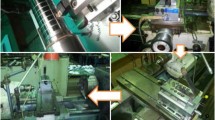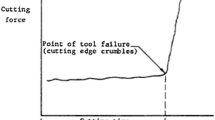Abstract
End milling is one of the most common metal removal operations encountered in industrial processes. Product quality is a critical issue as it plays a vital role in how products perform and is also a factor with great influence on manufacturing cost. Surface roughness usually serves as an indicator of product quality. During cutting, surface roughness measurement is impossible as the cutting tool is engaged with the workpiece, chip and cutting fluid. However, cutting force measurement is easier and could be used as an indirect parameter to predict surface roughness. In this research work, a correlation analysis was initially performed to determine the degree of association between cutting parameters (speed, feed rate, and depth of cut) and cutting force and surface roughness using adaptive neuro-fuzzy inference system (ANFIS) modeling. Furthermore, the cutting force values were employed to develop an ANFIS model for accurate surface roughness prediction in CNC end milling. This model provided good prediction accuracy (96.65 % average accuracy) of surface roughness, indicating that the ANFIS model can accurately predict surface roughness during cutting using the cutting force signal in the intelligent machining process to achieve the required product quality and productivity.
Similar content being viewed by others
References
Sánchez JA, Ortega N (2009) Machine tools for high performance machining. Machine Tools for High Performance Machining. Springer London. doi:10.1007/978-1-84800-380-4_9
Ramesh R, Ravi Kumar KS, Anil G (2009) Automated intelligent manufacturing system for surface finish control in CNC milling using support vector machines. Int J Adv Manuf Technol 42(11–12):1103–1117. doi:10.1007/s00170-008-1676-1
Hamdan A, Sarhan AAD, Hamdi M (2012) An optimization method of the machining parameters in high-speed machining of stainless steel using coated carbide tool for best surface finish. Int J Adv Manuf Technol 58(1–4):81–91. doi:10.1007/s00170-011-3392-5
Sayuti M, Sarhan AAD, Tanaka T, Hamdi M, Saito Y (2013) Cutting force reduction and surface quality improvement in machining of aerospace duralumin AL-2017-T4 using carbon onion nanolubrication system. Int J Adv Manuf Technol 65(9–12):1493–1500. doi:10.1007/s00170-012-4273-2
Davim JP (2008) Machining : fundamentals and recent advances. springer, British Library Cataloguing in Publication Data. doi:10.1007/978-1-84800-213-5
Yang L-D, Chen JC, Chow H-M, Lin C-T (2005) Fuzzy-nets-based in-process surface roughness adaptive control system in end-milling operations. Int J Adv Manuf Technol 28(3–4):236–248. doi:10.1007/s00170-004-2361-7
Maher I, Eltaib MEH, El-Zahry RM Surface roughness prediction in end milling using multiple regression and adaptive neuro-fuzzy inference system. In: international conference on mechanical engineering advanced technology for industrial production, Assiut University, Egypt, 12-14/December 2006. Assiut University, pp 614–620
Asiltürk İ (2012) Predicting surface roughness of hardened AISI 1040 based on cutting parameters using neural networks and multiple regression. Int J Adv Manuf Technol 63(1–4):249–257. doi:10.1007/s00170-012-3903-z
Zhang JZ, Chen JC (2006) The development of an in-process surface roughness adaptive control system in end milling operations. Int J Adv Manuf Technol 31(9–10):877–887. doi:10.1007/s00170-005-0262-z
Wang X, Feng C (2002) Development of empirical models for surface roughness prediction in finish turning. Int J Adv Manuf Technol 20(5):348–356
Abellan-Nebot J, Romero Subirón F (2010) A review of machining monitoring systems based on artificial intelligence process models. Int J Adv Manuf Technol 47(1–4):237–257. doi:10.1007/s00170-009-2191-8
Özel T, Karpat Y (2005) Predictive modeling of surface roughness and tool wear in hard turning using regression and neural networks. Int J Mach Tools Manuf 45(4–5):467–479. doi:10.1016/j.ijmachtools.2004.09.007
Sayuti M, Sarhan AAD, Fadzil M, Hamdi M (2012) Enhancement and verification of a machined surface quality for glass milling operation using CBN grinding tool—Taguchi approach. Int J Adv Manuf Technol 60(9–12):939–950. doi:10.1007/s00170-011-3657-z
Chandrasekaran M, Muralidhar M, Krishna CM, Dixit US (2010) Application of soft computing techniques in machining performance prediction and optimization: a literature review. Int J Adv Manuf Technol 46(5–8):445–464. doi:10.1007/s00170-009-2104-x
Szecsi T (1999) Cutting force modeling using artificial neural networks. J Mater Process Technol 92–93(0):344–349. doi:10.1016/S0924-0136(99)00183-1
Zalnezhad E, Sarhan AAD, Hamdi M (2013) A fuzzy logic based model to predict surface hardness of thin film TiN coating on aerospace AL7075-T6 alloy. Int J Adv Manuf Technol 68(1–4):415–423. doi:10.1007/s00170-013-4738-y
Kumanan S, Jesuthanam CP, Ashok Kumar R (2008) Application of multiple regression and adaptive neuro fuzzy inference system for the prediction of surface roughness. Int J Adv Manuf Technol 35(7–8):778–788. doi:10.1007/s00170-006-0755-4
Chang C-K, Lu HS (2006) Study on the prediction model of surface roughness for side milling operations. Int J Adv Manuf Technol 29(9–10):867–878. doi:10.1007/s00170-005-2604-2
Kirby ED, Chen JC, Zhang JZ (2006) Development of a fuzzy-nets-based in-process surface roughness adaptive control system in turning operations. Expert Systems with Applications 30(4):592–604. doi:10.1016/j.eswa.2005.07.005
Upadhyay V, Jain PK, Mehta NK (2013) In-process prediction of surface roughness in turning of Ti–6Al–4V alloy using cutting parameters and vibration signals. Measurement 46(1):154–160. doi:10.1016/j.measurement.2012.06.002
Maher I, Eltaib MEH, Sarhan AD, El-Zahry RM (2014) Investigation of the effect of machining parameters on the surface quality of machined brass (60/40) in CNC end milling—ANFIS modeling. Int J Adv Manuf Technol:1–7. doi:10.1007/s00170-014-6016-z
Kasabov NK (1997) Foundations of neural networks, fuzzy systems, and knowledge engineering, vol 33. Computers & Mathematics with Applications, vol 7. MIT Press, Cambridge, MA. doi:10.1016/S0898-1221(97)84600-7
Jang J-SR, Sun C-T, Mizutani E (1997) Neuro-fuzzy and soft computing : a computational approach to learning and machine intelligence. MATLAB curriculum series. Prentice Hall, Inc, USA
Fuller R (1995) Neural fuzzy systems. Berlin/Heildelberg,
Bhattacharyya A (1996) Metal cutting theory and practice, 1st edn. Agency, New Central Book
Childs T, Maekawa K, Obikawa T, Yamane Y (2000) Metal Machining Theory and Applications. John Wiley & Sons Inc, North, Central and South America
Philip PK (1971) Built-up edge phenomenon in machining steel with carbide. Int J Mach Tool Des Res 11(2):121–132. doi:10.1016/0020-7357(71)90021-7
Fang N, Pai PS, Mosquea S (2010) The effect of built-up edge on the cutting vibrations in machining 2024-T351 aluminum alloy. Int J Adv Manuf Technol 49(1–4):63–71. doi:10.1007/s00170-009-2394-z
Cassier Z, Prato Y, Muñoz-Escalona P (2004) Built-up edge effect on tool wear when turning steels at low cutting speed. J Mater Eng Perform 13(5):542–547. doi:10.1361/10599490420629
Author information
Authors and Affiliations
Corresponding author
Rights and permissions
About this article
Cite this article
Maher, I., Eltaib, M.E.H., Sarhan, A.A.D. et al. Cutting force-based adaptive neuro-fuzzy approach for accurate surface roughness prediction in end milling operation for intelligent machining. Int J Adv Manuf Technol 76, 1459–1467 (2015). https://doi.org/10.1007/s00170-014-6379-1
Received:
Accepted:
Published:
Issue Date:
DOI: https://doi.org/10.1007/s00170-014-6379-1




